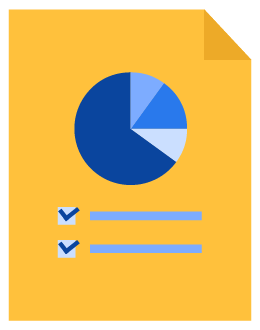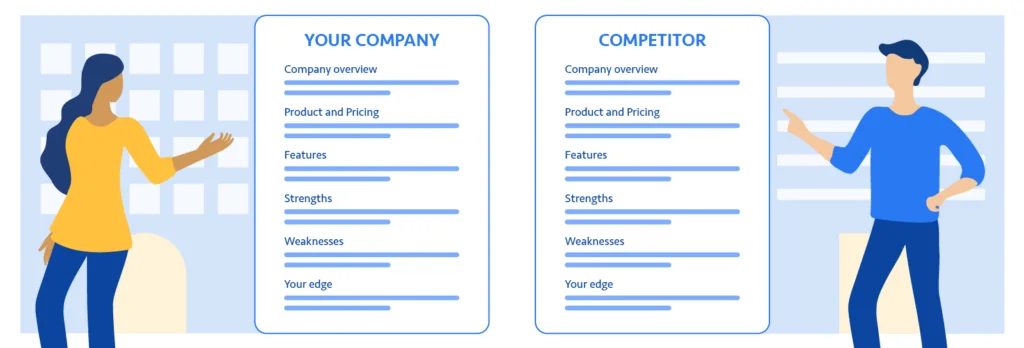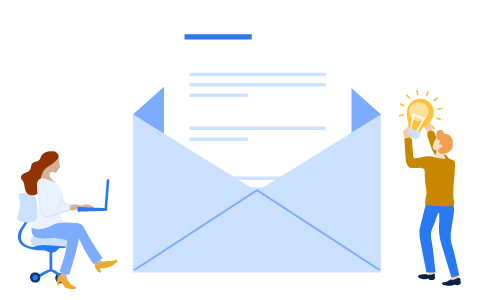Creating an SDR playbook is key to standardizing and optimizing your sales development process. However, the biggest mistake that any B2B organization can make is to treat the playbook as a one-off document.
Instead, your SDR playbook should be a living document. That way, it’ll allow your sales leadership team to revisit goals, redefine metrics, and review strategies.
This article will teach you how to create your own SDR playbook using our template based on our 15+ years of experience. We’ll also include tips on how to train your SDRs and best practices that allow you to target high-quality prospects from the start.
First, let’s cover the phases of drafting an SDR playbook.

Download the SDR Playbook Template
Ready to get started on your playbook? Our editable Word document allows you to customize your own playbook based on your unique processes.
How to create an SDR playbook
You’ll first need to think about who’s going to be involved in your playbook-writing process. We recommend relying on SDR and sales managers to write up the playbook with input from high-performing SDRs. You’ll also want to get approval from upper management, which is why we recommend involving them as early as possible.
From there, you’ll want to break your writing process down to 6 phases:
Phase 1: Defining objectives and goals – Not only do you need to define what success looks like for an SDR, you’ll also need to define what it looks like for your SDR playbook.
Phase 2: Gather documentation and resources – Start gathering all documentation that already exists, including your process docs, call scripts, and templates.
Phase 3: Writing the SDR playbook – Now comes the lengthy part: drafting. We’ll list out the 7 sections you need for a fleshed out playbook down below.
Phase 4: Getting approval from upper management – If you haven’t already, make sure you get buy-in from upper management.
Phase 5: Distribution and training – Now’s the time to share your playbook with the rest of your SDR department. We’ll cover how to roll out your playbook later in this post.
Phase 6: Evaluation and optimization – Be sure to evaluate your playbook every year. From there, make sure you’re adding newly optimized processes into your updated playbook.
Because developing a standardized sales development process can be a tedious process, many organizations choose to outsource their SDR team. Outsourced SDR teams, such as EBQ, allow you to build a team of experienced specialists at a fraction of the cost of hiring internally. For more information on what our team can do for you, visit our outsourced sales development page.
After your team has finished planning out your next SDR playbook rollout, it’s time to outline what each section of your playbook should include.
The SDR playbook structure
The overarching goal of creating an SDR playbook is to teach your SDRs how to succeed by giving them a repeatable process to follow. To do so, you must include all the information your SDR would need to help you reach your prospects.
Your playbook should include the following sections:
Section 1: Company Overview and Product Information
Section 2: Sales Org Structure and SDR Role
Section 3: ICP and Buyer Personas
Section 4: Messaging, Discovery Questions, and Competitive Positioning
Section 5: Lead Sources and Marketing Support
Section 6: Lead Rating and Touch Cadence
Section 7: Tech Stacks, Tools, and Rules of Play
To get started on creating your own SDR playbook, be sure to download our template. This template is an editable Word document to help you get started with your playbook draft.
Section 1: Company Overview and Product Information
This section should help your SDRs get familiar with your organization at a high-level.
You should include the following information within this introductory section:
- Quick introduction to the company: Include what your company does, what industry you’re in, and where your solution(s) fit in the market.
- Mission statement and company values: These messages should help align your entire company based on shared principles.
- Company organization chart: This helps your SDRs visualize the overall company hierarchy structure.
- Overview of products and pricings: This overview can be brief, as your SDRs should hand off leads to an AE once they are thinking about investing in your solution.
Section 2: Sales Org Structure and SDR Role
The goal of this section is to help your SDR understand the scope of their work and understand who to contact and when.
To help define the SDR’s role expectations, you should include the following information:
- Job description and training checklist: Define your SDR’s scope of work by including the job description. You should also include their role expectations during their initial ramp-up stage.
- Sales org chart: This is a more detailed description of who’s in the sales department, what their responsibilities are, and who’s reporting to whom.
- Communication guide: Outline who, how, and when the SDR should reach out to fellow team members. For example, you might include who your SDRs should send lead summaries to.
- Territories breakdown: This tells your SDRs how your contact database will be divided between them — whether that’s through geographic location, alphabetical order, or even type of industry.
Section 3: ICP and Buyer Personas
Your goal here is to help SDRs understand who to target based on the characteristics of your most valuable customers.
This section should have the following information:
- Ideal Customer Profile (ICP): Describes characteristics of specific companies targeted in an account-based strategy.
- Buyer Personas: Describes the individuals that make up the buying committee at your targeted companies.
- Qualification criteria: What characteristics of a lead makes it a great fit for your services (e.g. job titles, company size, annual revenue).
Many organizations use an ICP Matrix that combines buyer personas, which concisely puts all of this information together for your SDRs. It should also list out common pain points shared by these ideal customers — for example, what their roadblocks are and what would motivate them to purchase your solution.
Here’s an example of an ICP matrix for an organization targeting the cybersecurity industry:

Keep in mind that these individual’s pain points are dependent on their role within the company: either as an evaluator, influencer, or decision maker. While a typical decision maker is concerned about maximizing ROI, the evaluator is concerned with how it’ll help improve their team’s process.
A great way to see these pain points in real life is to list out a few case studies and success stories your company had in the past. Your SDRs can also reference these success stories in their own calls with prospects down the line.
Section 4: Messaging, Discovery Questions, and Competitive Positioning
This section’s purpose is to give your SDRs examples of how to connect with prospects on a human level.
To help create structure for your SDR’s conversations, we recommend creating cold calling scripts and email templates. That said, you should encourage your SDRs to put their own spin on their messaging. This makes it easier to create the personal connections with your prospects that you’re looking for.
You’ll also want to come up with discovery questions that allow your SDRs to learn more about your leads. The purpose of these questions is to help your salespeople figure out which one of your products will solve your prospect’s challenges the best. For more expert tips on these types of questions, be sure to visit our Discovery Call Questions blog post.
Finally, be sure to convey your competitive advantage using competitor battle cards. This allows you to compare your solutions with what competitors are offering. Be sure to include pricing information, key differences, and what makes your solution better.

Part of your messaging strategy is to also figure out what attracted a prospect to your organization in the first place. Next, we’ll cover the different types of lead sources and marketing support.
Section 5: Lead Sources and Marketing Support
Your goal for this section is to help SDRs understand where your leads are coming from. It’s important to know your lead sources because it’ll give you insight into what solutions your prospects may be interested in.
Examples of lead sources include:
- Product trial signups
- Form submissions
- Asset downloads
- Email campaigns
- Events and webinars
- Purchased list
- Intent data
Lead sources can also let you know how interested your prospects are in your solution. Think about it: the intention behind someone who subscribed to your newsletter is inherently different from someone who filled out your contact form. When you ask your SDRs to review these marketing-qualified lead sources, remind them to think critically on how curious your prospect is about your solution.
Take a moment now to expand on marketing support that generates leads for your SDRs. Our experts recommend listing out all branded collateral and campaigns that coexist with your sales efforts. This helps your SDRs understand how your product is positioned.
The purpose of identifying your prospect lead sources and marketing collateral is to give insight into what drew your prospects to you in the first place. That way, your SDRs can tailor their messaging to fit your lead’s unique needs better.
Section 6: Lead Rating and Touch Cadence
Understanding how to prioritize leads is a necessary skill any successful SDR must have. In this section, you’ll help your SDRs understand how to score your leads based on their interest and how often to contact these prospects.
You’ll first need to outline a lead rating system that can accurately gauge how engaged your prospect is with your outreach efforts. At EBQ, we use our own EBQ Rating system to identify when to follow up with your leads based on their scores.

You should then outline a touch cadence to help SDRs determine when to follow up with prospects and which channels to use — such as a phone call, voicemail, or email. We’ve outlined an example cadence block strategy below based on how warm or cold the prospect is:

Having covered these key components of your sales development strategy, let’s now take a look at how to explain your sales tech stack and its associated rules.
Section 7: Tech Stacks, Tools, and Rules of Play
Your final section should establish rules of your technology to ensure your SDRs are using your tools correctly. After all, your technology investment isn’t cheap; you’ll want your SDRs to work more efficiently by using the tools that are available to them.
You’ll first want to list out all of your CRM guidelines. For example, our SDR playbook has both Salesforce CRM and HubSpot guidelines for our SDRs to follow as they work with clients to ensure prospect info is properly recorded.
For example, you may want to include the following information within your CRM guidelines:
- Which fields must be filled out and how to format them
- What information to include in their CRM notes
- How to assign leads to sales reps and convert leads
- How to keep your prospect data clean and consistent
- Any relevant shortcuts or other CRM features
From there, you should be listing out your other tools and their respective rules. In our SDR playbook, we list out best practices for organizing an email inbox and managing calendar invites. If your SDRs use any other prospecting tools to identify or research leads, we recommend including those instructions within this section as well.
Be sure to be specific about your rules of play. When writing each tool’s rules, you’ll need to include step-by-step instructions for each task — such as data entry. Be sure to include best practices and screenshots with real-life examples as well.
At this point, your first draft of your organization’s SDR playbook has been written. After getting your playbook approved, you’ll need to figure out how to distribute your SDR playbook.
Rolling out your SDR playbook training program
Now that your SDR playbook is ready for distribution, it’s time to plan how you’re going to train your new and tenured SDRs on your new processes.
You can break it down into 3 phases:
Phase 1: Onboarding – During your SDR’s orientation, a manager should explain and share the playbook with these new hires.
Phase 2: Training – Throughout the SDR’s initial ramp-up period, their supervisor/mentor should be checking in regularly and making sure they’re following best practices.
Phase 3: Updates – Whenever you make an update to the playbook, be sure to host workshops and training sessions to ensure every SDR is up to date on your new and improved processes.
If you’re working in a remote environment, we recognize that virtual training has its inherent challenges. If you want tips on how to upskill WFH employees, be sure to read our How to Train Remote Employees & Upskill Your Workforce blog post.

Download the SDR Playbook Template
Ready to get started on your playbook? Our editable Word document allows you to customize your own playbook based on your unique processes.
Create an SDR playbook that helps your team succeed
On a high level, an SDR playbook helps you standardize your sales development process. More importantly, it gives your SDRs the knowledge they need to succeed in their role. That’s why it’s important to be strategic about what to include in your playbook.
As reiterated throughout the post, your SDR playbook should be a living document. Be sure to revisit your processes regularly to make sure you’re maximizing your sales development team. When you’re ready to develop your own playbook, make sure you download our SDR playbook template.
However, not every organization is ready to build out their own SDR team. If you’re looking for seasoned SDRs who are already trained on a proven process, be sure to contact one of our specialists to learn more about our outsourced sales development page.



